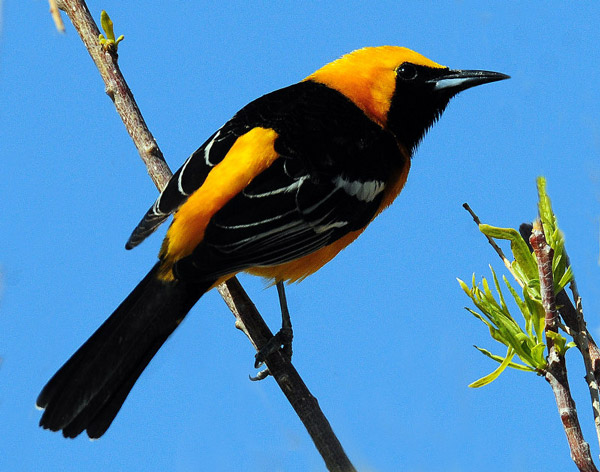|
Utah Bird Profile |
||||||||
|
Name Roots: (Gr. ikteros, "jaundice, yellow" - L. cuculla, " a hood") |
||||||||
| In Utah: |
 by Paul Higgins |
|||||||
| Nesting, feeding, characteristic behaviors: |
The nest is woven of wiry green grass blades or shredded palm or yucca
fibers. ~ Merrill Webb Nests in a deciduous tree or in a yucca at a height of 12-45 feet, in a pendant nest. This species is a frequent cowbird host. During the breeding season, this species is an omnivore: lower-canopy forager. |
|||||||
| Habitat: | Breeds in Utah in lowland riparian
and high desert scrub habitats. |
|||||||
| How to find: |
The Hooded Oriole is one of the most beautiful songbirds found in Utah.
Found only in southern Utah, it has actually extended its range into the St.
George area due to the planting of ornamental palm trees.. The nest is woven
of wiry green grass blades or shredded palm or yucca fibers. This oriole
regularly occurs in the Beaver Dam Wash at the Lytle Ranch Preserve. From
1974 to the present I have 33 records from the ranch, the earliest being
April 4 and the latest September 17. The majority of these records are
during April, May and June. Another consistent location for observing this
species is near the south entrance (700 West Diagonal) to the Red Hills Golf
Course in St. George where there are a couple of large palm trees in which
it nests. Dixie College has added some palm trees to its landscape, also,
and I have seen this oriole (on occasion) along 700 East between 200-300
South in St. George.
~ Merrill Webb |
|||||||
|
|
USGS Profile
(Geological Survey) |
US
Winter Range Map |
US
Summer Range Map | |
||||||||
|
||||||||
|
Abbreviations | References | Legend
|
||||||||